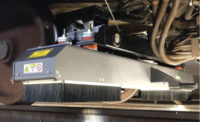Thanks to a box-jacking method new to the U.S., a contractor “ambassador” program and flexibility allowed by design-build, the New York Metropolitan Transportation Authority (MTA) is well underway with a $2.6-billion, 10-mile project to add a third track to the Long Island Rail Road (LIRR) commuter line.
Running from Floral Park, N.Y. to Hicksville, N.Y., the effort constitutes one of the region’s most significant transportation infrastructure projects. Major project elements include elimination of eight grade crossings, new parking facilities, upgrades to railroad infrastructure and improvements to stations.
Before the COVID-19 pandemic hit, the stretch of railway served about 100,000 commuters a day, running 250 trains, says Thomas McGuinness, MTA deputy project manager for the main line expansion. With only two current tracks, “during peak flow, you assume one [flow of traffic] in each direction,” he says. “We have peak flow schedules set up that utilize both tracks in peak flow directions for short periods of time. But it hampers reverse commutes.”
The future third track will accommodate those reverse commutesh, McGuinness says. “We will increase capacity by 50%,” he says. The third track also will allow for increased flexibility around maintenance issues that might pop up, he adds.
The work by 3rd Track Constructors (3TC), a consortium of Dragados USA, John P. Picone, Halmar International and CCA Civil, includes replacement of communications, signals, track work, switches, substations and power sources. 3TC holds a $1.7-billion design-build contract with a scheduled completion date of late 2022. That schedule is still on track despite the pandemic, officials say.
Two grade crossings have been eliminated, says McGuinness. Crews are also replacing or rehabilitating seven bridges, ensuring that their clearances are at least 14 ft. Five stations are being upgraded or rebuilt. “There will be more platform space, more overhead canopies, Wi-Fi, communications—a real focus on an aesthetic upgrade,” says Susan Walter, executive vice president of Stantec, lead designer on the 3TC team. Stations will also receive security enhancements such as cameras and bollards and will be compliant with the Americans with Disability Act.
Work is almost complete on a new five-level, 551-space parking garage at Mineola Station, replacing the surface parking area. The garage, which consists of 600 precast concrete sections, will be completed this fall.
Walter says the main challenge lies in “just the size and volume of work associated with this project and being able to coordinate the design with all of our partners. We’re all in lockstep moving forward. It’s a lot easier in the pursuit phase. Now we’re really working on the day-to-day details. Like any project, it takes laser-focus communication between the parties to really move the design from the concept to the final design.”
Thanks to flexibility and communication, the contractor was able to choose a box-jacking system from Italian firm Petrucco that allows for new underpasses to be placed over a weekend, rather than causing weeks of disruption.
Jacked Up
Petrucco’s system, never before used in the U.S., utilizes hydraulic jacks and spreaders to move a cast-in-place concrete box carrying the entire underpass and rail bridge into place in a matter of hours. “It’s accelerated bridge construction,” says McGuinness. “You construct a new bridge superstructure and substructure, almost like a culvert U-structure. [Crews] set the steel superstructure on top and remove the sheeting supporting the railroad.” Hydraulic jacks then push the structure into place.
This method requires closure of the local street for about 180 days. “In the past, similar projects were stand-alone, and could take a year of planning and one to two years to complete,” says McGuinness. “Here, they are integrated into one contract; we completed three bridges and two grade crossings in one season.”
“We’re in lockstep moving forward.”
– Susan Walter, Executive Vice President, Stantec
The first installation, at Urban Avenue in Westbury, N.Y., was performed on July 20, 2019. The second installation, on Covert Avenue in New Hyde Park, N.Y. on Aug. 24, went even smoother as crews got accustomed to the method.
The Covert Avenue box consists of a 112-ft by 40-ft reinforced concrete slab, with 24-ft side walls and two spans on top bearing rail and a roadway. Crews cast the 2,000-tonne concrete box on site, and then slid it 58 ft into place.
The box is pushed off a concrete launching slab, but that slab does not extend the full distance it will travel. At the Covert Avenue site, the box’s final position is half on the slab and half on soil. At the earlier Urban Avenue site, the box’s final position was entirely on soil.
According to Petrucco, the company has performed rail underpass box-jackings some 1,500 times globally, including in Spain, Canada and Qatar, since the method was first introduced in 1978.
Work is underway to eliminate the next grade crossing, at New Hyde Park Road. The project began with utility relocation last spring and demolition of the road. Crews began drilling soldier piles in September to shore up the excavation area. Excavation began in February, with a planned seven-month road closure.
During a weekend double-track outage planned for July 11-12, the existing tracks and systems will be removed to allow for excavation under the shored-up tracks. Then the bridge will be pushed into place with 20 hydraulic jacks, each with a capacity of 250 tons for a total of 5,00 tons of jacking force. The jacking system is capable of pushing the bridge 20 in. with each stroke. After each push, it must be reset. Over the course of the weekend, the jacking system will be reset 30 times to move the bridge 50 ft into its final position.
LIRR is well over a century old as are “most of the towns and villages built up around it,” says McGuinness. “So you have a lot of local businesses. Your cranes are running through districts. There’s not much room.” Crews are staging and storing equipment within the railroad right-of-way. Construction activity often occurs just feet from residences.
“It’s 10 miles long, and you have, for every work element, different people with some level of say,” says Alan Paskoff, 3TC project executive. “In some locations, you have a community on one side of the right-of-way and another on the other side. Villages, counties, towns—multiple people with different rules and needs. One thing 3TC brought to the table is a strong outreach program. We’re used to working in urban areas, so coming out to the suburbs is a different challenge. We’re literally in people’s backyards.”
Spreading Goodwill
To reduce impacts and increase goodwill, 3TC and the MTA established an extensive outreach program.
“Local ambassadors are assigned to each municipality,” explains McGuinness. “We hold monthly meetings with local officials. We have commitments to reduce noise levels. We measure air quality, vibrations, noise.” Mitigation measures have included sound curtains, soundwalls and temporary fencing.When 3TC did the first grade crossing, it set up an ice cream truck handing out free treats and rebuilt two Little League fields used for construction, says Paskoff. The team even has been building its brand. “We have a couple of street sweepers out there,” he says. “One of the mayors recommended that we put our name on the side of them.”
“We’re literally in people’s backyards.”
– Alan Paskoff, 3TC Project Executive
There is a community center dedicated to providing information about the project, although at press time it was closed. Paskoff says 3TC’s appointed ambassadors have attended meetings of chambers of commerce and historical societies, among others. “We know the building owners and business owners,” Paskoff says.
The resulting goodwill has been key to project success. “We’re working 24/7 in different locations, sometimes nighttimes and weekends,” says Paskoff. He recalls that when crews built a new bridge at Cherry Lane, “there was a woman on the corner almost in the middle of the zone, watering her flowers and watching the work.”
Moreover, “sometimes we have to move people out of their homes for a weekend because of the noise,” Paskoff adds. “They understand what’s going to happen. We’ve had to take parking lots sometimes from business owners. [They realize that the] more they help us, the quicker we get out of their neighborhoods.”
Based on survey feedback from municipalities, 3TC can receive incentives of up to $250,000 per quarter, says McGuinness. “We distribute scorecards to local residents and municipalities about the contractor’s performance in maintaining commitments to communities,” he notes. “The scores drive how much of that incentive the contractor receives.” 3TC has been scoring well; it earned $183,000 last quarter, which is about typical, McGuiness adds.
Collaboration
Thanks to contractor input early on, the new third track will run mostly on the south side of the existing two tracks beginning at the Floral Park station. “It stays on the south through the entire corridor through Westbury,” McGuinness points out. “East of Westbury, it adjusts to the north side.” Moving parts of the new track to the south simplified some construction phasing, he notes.
McGuiness says while the project is under one contract, “it’s broken down into 50 elements. Each element is a stand-alone project. Eliminating a grade crossing is one project. Replacing a station is another. What’s challenging is that your schedule is not linear. There’s no clear path to follow in the logic of a CPM [critical path method] schedule.”
“It’s broken down into 50 elements. Each element is a stand-alone project.”
– Thomas McGuinness, MTA Deputy Project Manager
Working with multiple design partners, including MBE/WBE/veteran-owned firms, adds to the complexity of the many moving pieces. Says Stantec’s Walter: “Another layer is that of adding the need to do continual constructibility reviews at each phase of design.” Designers must reach out to the right-of-way team, civil engineers, structural engineers and landscape architects, she adds.
The moving parts of 50 elements are put into six “buckets,” says McGuinness. “The managers of those buckets are like project managers themselves. On a higher level, senior management ensures coordination of those buckets.”
Another challenge is that essentially a whole new railroad is being built while the existing one keeps running. “New signals, utilities, communications—you’re putting in in a new interface with a new system,” says Walter. “Adding a third track—all that infrastructure that makes the trains run safely—requires a lot of systems expertise.”
3TC has weekend outages locked in six to nine months in advance, says Paskoff. “That has really meant we’re all in this together and committed to the schedule. We just can’t let these dates slide.”
So far, the schedule has not slid, even with the coronavirus. “Our workforce has not been hit,” says Paskoff, noting a few cases of self-quarantining. With ridership down 90% and trains running on a weekend schedule, “we identified some opportunities for additional time on the tracks. We have not missed a beat on the design side. On the construction side, things have changed a bit regarding where and when we can work.”













Post a comment to this article
Report Abusive Comment